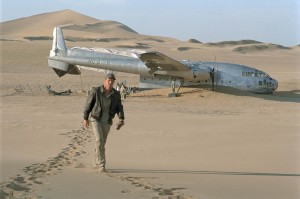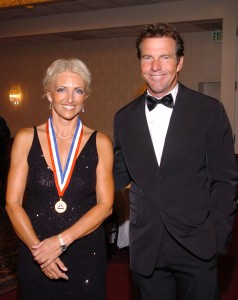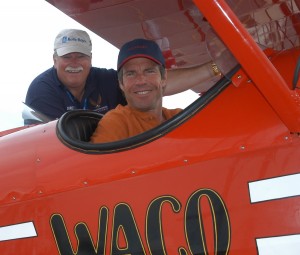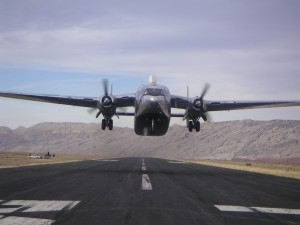By Di Freeze
It’s not a stretch for Dennis Quaid to play Capt. Frank Towns in “The Flight of the Phoenix,” to be released October 22. Quaid’s been a pilot since the early eighties, when he decided to learn to fly to ready himself for the role of Mercury astronaut Capt. Gordon Cooper in “The Right Stuff,” released in 1983.

As Capt. Towns in the reinvented “Flight of the Phoenix,” Quaid is filling some famous shoes. James Stewart played the role in the original film, released in 1965.
“I felt like I should learn to fly, because that’s what these guys did,” he said. “It helps you get into the role. Right after getting it, I found out Gordo Cooper lived a couple of miles from me in LA. I went over and talked to him, and he turned me on to Clay Lacy.”
Before that, Quaid admits, he was afraid to fly.
“I really didn’t understand aerodynamics,” he said. “Also, I had an ex brother-in-law who took me up in a little plane, cut the engine and put it into a spin.”
“Ha ha ha,” Quaid mimicked the evil laugh that accompanied the deed. “Things like that. I was about to throw up. So I was sort of turned off to little planes.”
Quaid remembers his flight with the expert pilot that would help turn that fear to excitement.
“Clay gave me a ride in a Learjet at about 50 feet off the deck over the Mojave Desert,” he said. “That was quite a thrill.”
Then, Lacy directed him toward a good flight instructor.
“Clay turned me on to Bud Whalen, who was over at Van Nuys Airport,” Quaid said. “That was back in the early eighties, and he was already seventy-something years old. I figured he was only three years younger than aviation itself.”
Quaid said Whalen’s style worked out well for him.
“He was a seat-of-the-pants type of teacher,” he said. “That actually worked out for me pretty well, because it was a good way to learn to fly–all by feel.”
In 1981, with about 12 hours under his belt, Quaid soloed in a Cherokee 180. He smiles and says he definitely remembers how he felt that day.
“Yeah, I think every pilot remembers that moment,” he says. “We kept doing touch and goes, and then Bud said, ‘Pull over!'”
The next thing Quaid recalls is his instructor saying, “Been nice knowing you!”
“I took off,” Quaid said.
He said it took a while before he realized what the absence of Whalen actually meant–the fulfillment of his dream to fly.
“You’re thinking so much about everything,” he said. “You’re so busy when you’re taking off…then you’re seeing where you’re supposed to be. When I called midfield, that was the first time I had a chance to actually have a little time to turn around in the airplane and see that there was nobody there.”
Quaid said he’s never quite had the same feeling since then.
“That memory is very vivid,” he said. “It’s a special time for every pilot.”
In his early days of flying, Quaid rented various aircraft, before acquiring a TC Bonanza.
“For the way I use airplanes, it’s maybe the best plane I ever had,” he said. “That was a really nice airplane. I loved it. I kind of wished I hadn’t sold it.”
After the Bonanza, Quaid got checked out for twin engine, and bought a Cessna 421.
“Then I went to a Cessna Citation II,” he said. “I went down to FlightSafety and got certified for jets. That was a great airplane, too.”
He has accumulated about 1,800 hours.
“The first year I got my Citation, I flew it about 400 hours,” he said. “The last year I had it, I flew it less than 100 hours. It makes your price per hour go way up.”
Quaid has often flown to film locations, and flew the Citation several times to Central America, where he does a charity.
“I’d fly to Belize, Honduras, Nicaragua–pretty much all over the place,” he said. “I used it a lot to fly up to Montana. That’s really great.”
He lists flying over the Grand Canyon as one of the more memorable flights he’s taken.
“We flew over before they shut it down for flyovers,” he said. “We came over the Grand Canyon pretty low. That was really something. I loved that flight. It was just like being on a magic carpet.”
Quaid says he’s “between planes” right now, and has been renting and chartering lately.
“The Flight of the Phoenix”
As Capt. Towns in the reinvented “Flight of the Phoenix,” Quaid is filling some famous shoes. James Stewart played the role in the original film, based on a novel by Elleston Trevor, released in 1965, and directed by Robert Aldrich.
John Moore, who made “Behind Enemy Lines” (2001), directed the 20th Century Fox remake. Quaid says he doesn’t believe Moore’s decision had anything to do with the fact he’s a pilot.
“I think they saw ‘The Rookie’ and thought I had the right qualities,” he said. “I don’t think he even knew I was a pilot.”
Quaid admits he likes pilot roles, since they contributes to the excitement of his real-life piloting, but there was another reason he was happy to get this role.
“As a kid, that was one of my dad’s favorite movies,” he said. “So I’d seen it before.”
Quaid was very familiar with the original story line about a captain of an oil company transport that gets lost in a sandstorm and crash-lands in the Sahara Desert. For the remake, several changes were made to update the story line, including moving the setting to Mongolia’s Gobi Desert.
“I thought it was a really good script and wanted to be part of it,” Quaid said.
He says “The Flight of the Phoenix” is a great aviation movie, but that it transcends aviation.
“The movie is really about hope,” he says. “This disparate group of people are thrown together and don’t want to be together. They crash-land in the desert, in the middle of nowhere, and know they’re not going to be found. They build another airplane out of the wreckage of the one that crashed in order to get out. They have to come together and help each other, work together, to save themselves.”
Quaid said Moore did a great job on the film, which also stars Giovanni Ribisi, Miranda Otto, Hugh Laurie and Jared Padalecki.
“It’s still a study of people, and you really get involved with these people and what they’re going though, but there’s a lot more action in it,” Quaid said. “The difference about this one is the special effects they have nowadays. They’re incredible. It’s been updated, although the plane is still an antique plane.”
In the original movie, Stewart is piloting a C-82 Packet when it crash-lands. In the remake, Hawkins & Powers Aviation, of Greybull, Wyo., one of the nation’s largest air tanker operators as well as the operator of the Museum of Flight & Aerial Firefighting, provided a flyable C-119C Flying Boxcar, Fairchild’s follow-on to the Packet. Fox also scoured aviation junkyards for aircraft that would be destroyed during the making of the film, and came up with three C-119s for that purpose.

Dennis Quaid served as master of ceremonies for the enshrinement ceremony, during which Patty Wagstaff, air show headliner and three-time U.S. National Aerobatic Champion, accepted enshrinement.
In the original film, legendary stunt pilot Paul Mantz was killed flying the Phoenix P-1, the aircraft that “rises up” out of the remains of the cargo plane. The film was dedicated to him. (See “Paul Mantz and the Last Flight of the Phoenix” in this section, page 13.)
During four months of filming in Namibia, Quaid took advantage of some free time to explore the bush from the cockpit of a twin-engine Cessna.
“We did a lot of flying over there, because we shot in Africa,” he said. “I hooked up with a guy who let me fly quite a bit. We’d go on safari and fly into these little strips way into the bush. You’d have to sort of come over the runway to chase the animals off of it before we landed. That was a thrill.”
Master Of Ceremonies For NAHF
Quaid served as master of ceremonies for the National Aviation Hall of Fame’s 43rd Annual Enshrinement Ceremony on July 17, in Dayton, Ohio.
The actor brought along 12-year-old Jack Quaid, his son with his former wife, actress Meg Ryan, who took his place in the audience as his dad announced the enshrinement of William A. Anders, former Apollo astronaut and nuclear energy expert; the late Harriet Quimby, America’s first officially licensed woman pilot; the late Jack L. Ridley, pioneering flight test engineer and pilot; and Patty Wagstaff, air show headliner and three-time U.S. National Aerobatic Champion.
The Quaids took the opportunity to mingle with guests, which included Neil Armstrong.
“That was a big deal for both of us,” he said.
In fact, Quaid compared meeting Armstrong to meeting Christopher Columbus. At the event, Quaid also had a chance to renew acquaintances with Chuck Yeager, whom he’d visited with on the set of “The Right Stuff” several times.
“It was good to see him,” he said. “I hadn’t seen him in years.”
The Quaids ended their trip to Dayton by visiting the 2004 Vectren Dayton Air Show, held July 17 and 18 at Dayton International Airport. Escorted by Ron Kaplan, director of marketing for NAHF, they stopped to visit with various exhibitors, including Waco owner Alan Hoeweler, whose 1928 model ATO won the Orville and Wilbur Wright Trophy (antique category) at the 2004 Rolls-Royce National Aviation Heritage Invitational/Eastern Regional.

While visiting the 2004 Vectren Dayton Air Show, Dennis Quaid stopped to admire Alan Hoeweler’s 1928 Waco ATO, which won the Orville and Wilbur Wright Trophy at the 2004 Rolls-Royce National Aviation Heritage Invitational/Eastern Regional.
Besides trying out the cockpit of that aircraft, they also got a feel for David Tallichet’s B-17 “Memphis Belle” (which was in the 1990 movie), and Ray and Sherri Dieckman’s Corsair, “Marine Dream,” which as a former NAHI winner (Reno 2000) was displayed among the RR/NAHI competitors, along with 2003 Dayton/NAHI winner “Glacier Girl,” Roy Shoffner’s P-38.
The Quaids had a chance to glimpse some of Sean Tucker’s performance in the “Tora Tora Tora” show, and to take a walk down a line of military helicopters, before meeting up with Clay Lacy, who would be taking them back to their home in Bozeman, Mont., in a Lear 31. There, they’d be picking up three more passengers, as well as three dogs, before heading back to Van Nuys Airport.
Quaid explained the meeting in Dayton wasn’t the first time he’d seen Lacy since the early eighties, when he gave him that memorable ride.
“I’ve seen him a couple of times, because he’s over at Van Nuys, and that’s where I kept my airplane,” he said. “He’d come barreling in and out of there.”
One question that’s left to be answered is if Jack, who’s “been around the world three times already,” will inherit his dad’s interest for flight. So far, said Quaid, he hasn’t seen any signs of interest.
“But he’s only 12 years old,” he clarifies.
Background
Born on April 9, 1954, in Houston, Quaid, the son of an electrician, graduated from Bellaire High School in Bellaire, Texas, in 1972. He later attended the University of Houston.
Quaid studied drama in high school and college, but dropped out before completing his studies. Like his brother Randy, he was intent on pursing an acting career, so he moved to Los Angeles.

Dennis Quaid and Clay Lacy, at Dayton International Airport, before the flight back to Bozeman, Mont. Lacy helped cure Quaid of his fear of small aircraft in the early 1980s, with a thrilling Learjet flight over the Mojave Desert.
Between 1975 and 1979, he had small roles in a handful of movies. He began to gain notice when he appeared in “Breaking Away” in 1979, and earned strong reviews for his role as Cooper in “The Right Stuff.”
Quaid has starred in over 50 movies, including “The Long Riders” (1980), ‘Jaws 3-D” (1983), “The Big Easy” (1987), “Innerspace” (1987), “D.O.A.” (1988), “Everybody’s All-American” (1988), “Great Balls of Fire” (1989), “Wyatt Earp” (1994), “Something to Talk About” (1995), “The Parent Trap” (1998), “Frequency” (2000), “The Rookie” (2002), “Far from Heaven” (2002), “Cold Creek Manor” (2003) “The Alamo” (2004) and “The Day After Tomorrow” (2004) . He directed the TV production of “Everything that Rises” in 1998, in which he also starred. He also served as executive producer on the movie that portrayed some of the harsh struggles that can plague today’s American farmer.
This year, Quaid will also star in the upcoming drama, “Synergy,” to be released December 29. He plays a middle-aged ad exec faced with a new boss who’s nearly half his age– and who also happens to be sleeping with his daughter.
One wish that the 50-year-old actor has is to mirror his personal life by making a movie about one of his favorite pastimes.
“I’m a golfer,” he said. “I’d love to do a golf movie.”
Quaid, who recently wed Kimberley Buffington, a 32-year-old Texas real estate agent, is also a musician; he plays guitar with his band, the Sharks.













